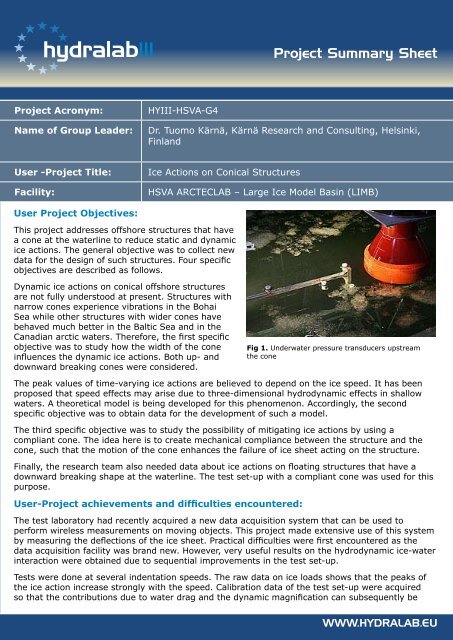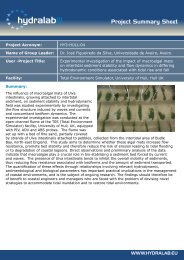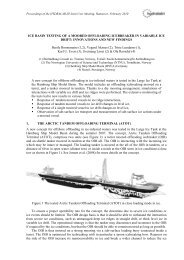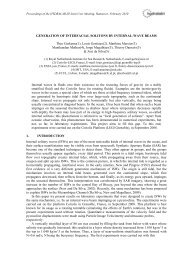Project Summary Sheet
Project Summary Sheet
Project Summary Sheet
Create successful ePaper yourself
Turn your PDF publications into a flip-book with our unique Google optimized e-Paper software.
<strong>Project</strong> <strong>Summary</strong> <strong>Sheet</strong><br />
<strong>Project</strong> Acronym:<br />
Name of Group Leader:<br />
HYIII-HSVA-G4<br />
Dr. Tuomo Kärnä, Kärnä Research and Consulting, Helsinki,<br />
Finland<br />
User -<strong>Project</strong> Title:<br />
Facility:<br />
Ice Actions on Conical Structures<br />
HSVA ARCTECLAB – Large Ice Model Basin (LIMB)<br />
User <strong>Project</strong> Objectives:<br />
This project addresses offshore structures that have<br />
a cone at the waterline to reduce static and dynamic<br />
ice actions. The general objective was to collect new<br />
data for the design of such structures. Four specific<br />
objectives are described as follows.<br />
Dynamic ice actions on conical offshore structures<br />
are not fully understood at present. Structures with<br />
narrow cones experience vibrations in the Bohai<br />
Sea while other structures with wider cones have<br />
behaved much better in the Baltic Sea and in the<br />
Canadian arctic waters. Therefore, the first specific<br />
objective was to study how the width of the cone<br />
influences the dynamic ice actions. Both up- and<br />
downward breaking cones were considered.<br />
Fig 1. Underwater pressure transducers upstream<br />
the cone<br />
The peak values of time-varying ice actions are believed to depend on the ice speed. It has been<br />
proposed that speed effects may arise due to three-dimensional hydrodynamic effects in shallow<br />
waters. A theoretical model is being developed for this phenomenon. Accordingly, the second<br />
specific objective was to obtain data for the development of such a model.<br />
The third specific objective was to study the possibility of mitigating ice actions by using a<br />
compliant cone. The idea here is to create mechanical compliance between the structure and the<br />
cone, such that the motion of the cone enhances the failure of ice sheet acting on the structure.<br />
Finally, the research team also needed data about ice actions on floating structures that have a<br />
downward breaking shape at the waterline. The test set-up with a compliant cone was used for this<br />
purpose.<br />
User-<strong>Project</strong> achievements and difficulties encountered:<br />
The test laboratory had recently acquired a new data acquisition system that can be used to<br />
perform wireless measurements on moving objects. This project made extensive use of this system<br />
by measuring the deflections of the ice sheet. Practical difficulties were first encountered as the<br />
data acquisition facility was brand new. However, very useful results on the hydrodynamic ice-water<br />
interaction were obtained due to sequential improvements in the test set-up.<br />
Tests were done at several indentation speeds. The raw data on ice loads shows that the peaks of<br />
the ice action increase strongly with the speed. Calibration data of the test set-up were acquired<br />
so that the contributions due to water drag and the dynamic magnification can subsequently be<br />
WWW.HYDRALAB.EU
<strong>Project</strong> <strong>Summary</strong> <strong>Sheet</strong><br />
considered.<br />
The time signals on ice load and the cone response were supplemented with video records and<br />
photos, which show all details of the ice failure process as well as the ice ride-up and clearing.<br />
Tests with the wide downward breaking cone showed, surprisingly, that the ice loads were<br />
significantly lower than predicted by the well-known model by Ralston. This result will probably<br />
call for modifications in the model concerned. During the tests the low level of ice actions posed<br />
problems for the tests with the compliant cone. The project solved this problem by increasing the<br />
buoyancy forces on the test structure. Accordingly, successful results were obtained also for the<br />
compliant cone.<br />
Highlights important research results:<br />
This project helped the test laboratory to demonstrate the feasibility of a new wireless data<br />
acquisition system that can be used to measure the dynamic deflections of the surface of an<br />
ice sheet. These deflections appear as wave propagation that emanates from the point where a<br />
model of a ship or a structure acts on the ice edge. The data that this project received from these<br />
measurements are of uttermost importance for the present project team. In addition, it seems clear<br />
that this test system will be very useful for the test laboratory in its efforts to enhance the quality<br />
of ice research.<br />
This project successfully compiled a significant amount of new data that four PhD students will use<br />
in modeling<br />
• hydrodynamic effects in dynamic ice actions,<br />
• the ice failure-and clearing processes that arise while an ice sheet acts on a conical structure,<br />
• mitigation of ice actions by using the concept of a compliant cone and<br />
• ice actions on floating platforms.<br />
In addition, the project team will introduce the new data as background information for an<br />
international expert group, which is finalizing the forthcoming standard ISO 19906 for arctic<br />
offshore structures.<br />
Fig 2. Ice failure on a narrow model cone<br />
Fig 3. Compliant cone acting on an ice sheet. Waterline<br />
Diameter 1.36 m and the cone angle 60o, downward breaking<br />
Publications:<br />
Kärnä, T. et al. (2010). Ice Failure Process on Fixed and Compliant Cones. Proceedings of the<br />
HYDRALAB III Joint Transnational Access User Meeting, Hannover, February 2010<br />
WWW.HYDRALAB.EU












